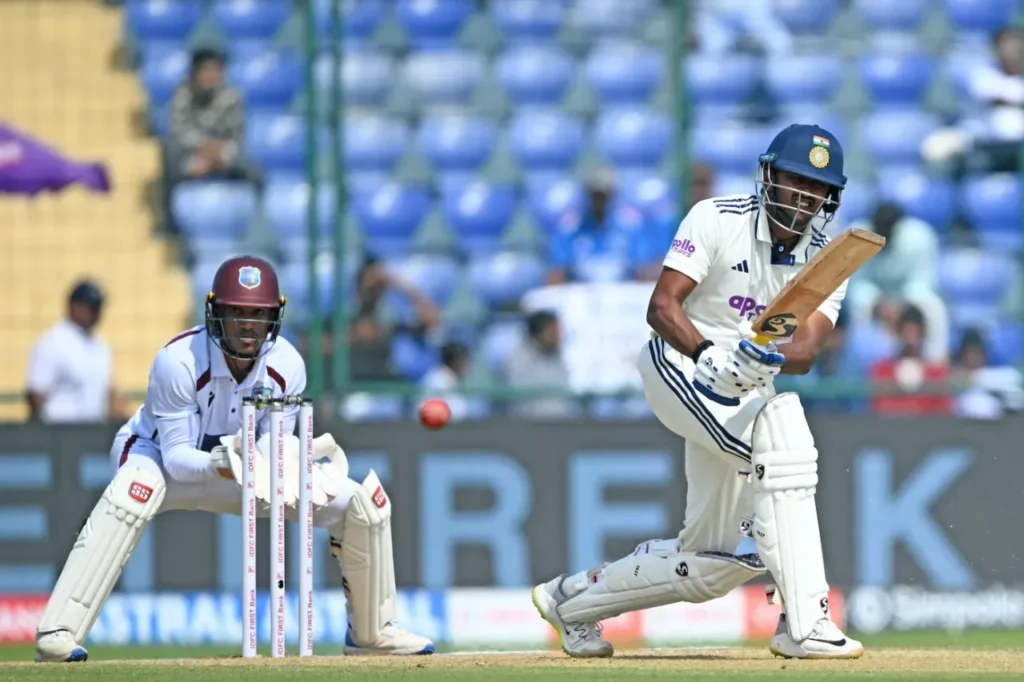New Delhi, October 10 — There are days in cricket that feel less like a contest and more like a declaration. Day 1 of the second Test between India and the West Indies at the Arun Jaitley Stadium was one of those.
On a bright autumn morning, Yashasvi Jaiswal batted with a blend of patience and power that silenced any whispers about form or maturity. His unbeaten 173, stitched together with a calm and composed 87 from Sai Sudharsan, put India in total command at 318 for 2 at stumps.
It wasn’t just the runs — it was the statement behind them.

A Start with Purpose
There was an energy about India from the moment Rohit Sharma won the toss and chose to bat. It wasn’t arrogance; it was intent. The surface looked good — a little grass, a hint of early movement — but everyone knew it would slow down later. This was a day to bat long, and bat hard.
Jaiswal walked out with KL Rahul, the experienced hand alongside the fearless left-hander. From the outset, Jaiswal’s approach was clear: settle first, punish later. His footwork was precise, his judgment outside off-stump confident. Rahul, meanwhile, looked fluent but occasionally uneasy against the new ball.
When Rahul fell for 38 — stumped off Jomel Warrican after being lured down the pitch — the score was 94 for 1, and it felt like a small opening for the West Indies.
But what followed shut that door completely.
The Partnership That Broke the Game Open
Sai Sudharsan, the young left-hander from Tamil Nadu, joined Jaiswal and together they produced a partnership that defined the day — 193 runs for the second wicket, built on clarity, communication, and control.
There was something refreshing about their approach. They weren’t in a hurry, but they weren’t stuck either. Every over seemed to have purpose — a nudge here, a crisp drive there, a single to rotate strike.
The two young batters complemented each other beautifully. Jaiswal was the aggressor when needed, stepping out to Warrican or driving through extra cover. Sudharsan was the anchor — compact, composed, and patient, waiting for his chances.
“We just kept telling each other to stay in the moment,” Sudharsan said at the end of the day. “There’s no need to chase runs when you know they’ll come naturally.”
By the time tea arrived, the pair had taken India past 200 with ease. The West Indian bowlers looked deflated, their lines losing bite, their energy fading.
Jaiswal’s Marathon
For those who’ve followed Yashasvi Jaiswal’s journey — from the maidans of Mumbai to the IPL spotlight and now the Test arena — this innings felt like another chapter in a remarkable story.
His 173* wasn’t about flash; it was about foundation. He began cautiously, respecting the early movement from Kemar Roach and Alzarri Joseph, and then slowly began to open up.
The hallmark of his innings was balance. Against pace, he played late and straight. Against spin, he used his feet — dancing down to smother the ball before it could bite.
His century came off 189 balls, a flick off his pads that ran away to the boundary. He raised his bat briefly, smiled toward the dressing room, and went straight back to work. No fist pump, no roar — just quiet focus.
“It’s about discipline,” Jaiswal said later. “Once you’re in, you can’t give it away. I’ve learned that the hard way.”
As the shadows lengthened across the Kotla outfield, Jaiswal reached 150 with a punch through midwicket — a shot that summed up his day: timing, patience, conviction.
He ended unbeaten on 173, his bat still full of intent, his eyes still hungry for more.
Sudharsan’s Coming of Age
If Jaiswal provided the substance, Sai Sudharsan provided the rhythm. His innings of 87 may not have reached three figures, but it was an innings of maturity and purpose.
From the moment he arrived at the crease, Sudharsan looked in control. His technique — still, compact, precise — allowed him to handle the left-arm spin of Warrican and the seam movement of Roach with equal ease.
He was particularly impressive through the off side, his cover drives flowing like poetry. His footwork against spin was measured, and his temperament — perhaps the most vital quality in Test cricket — never wavered.
His dismissal was a rare lapse. Trying to work Warrican through midwicket, he was trapped leg before — a ball that stayed a touch lower than expected. He reviewed, hoping for an inside edge, but technology confirmed the inevitable.
He walked off to a standing ovation — the crowd recognizing that his 87 had done the heavy lifting for India’s dominance.
The West Indies’ Long Day
It was, frankly, a difficult day for the visitors.
The West Indies started well in the morning session, finding a hint of swing and seam. Roach and Joseph beat the bat a few times, but without luck. Once the lacquer wore off, so did the menace.
Captain Kraigg Brathwaite tried everything — changing angles, bringing in short midwickets, and rotating his bowlers — but nothing worked for long.
Jomel Warrican, who took both wickets, was the only bowler who found consistent turn and accuracy. His figures of 2 for 60 from 25 overs reflected his persistence more than reward.
By the end of the day, the fielders looked weary. Shoulders dropped, conversations faded. When Gill joined Jaiswal in the evening, there was already a sense that the damage was done.
“We tried to stay patient,” Warrican said in the post-day presser. “But they batted really well. It’s about sticking to plans tomorrow.”
The Delhi Crowd and the Atmosphere
There’s a particular buzz at the Arun Jaitley Stadium when an Indian batter gets going. Every boundary is followed by a hum of satisfaction, every milestone by a roar that shakes the concrete stands.
As Jaiswal moved from 90 to 100, you could feel the tension turn to excitement. Fans stood, phones out, waiting to record the moment. When he reached three figures, the applause lasted nearly two minutes — the sound echoing long after he’d reset his stance for the next delivery.
Later, as Sudharsan approached his 50, the chants changed — “Sai, Sai, Sai!” — filling the air.
These are the small, human details that define Test cricket in India. It’s not just about numbers; it’s about connection. About a stadium full of strangers celebrating a shared joy.
Technique and Temperament
Both batters displayed something Indian cricket has long prized — a combination of technical soundness and mental steel.
Jaiswal’s discipline outside off-stump was particularly noteworthy. Gone were the airy drives and impulsive pulls. He left more, waited longer, and attacked only when he had to.
Sudharsan, meanwhile, looked built for Test cricket. His ability to absorb pressure and rebuild rhythm reminded many of an early Cheteshwar Pujara, but with a touch more elegance.
Together, they frustrated the West Indies, forcing errors and creating scoring opportunities out of patience.
The Bigger Picture
At 318 for 2, India have already done what every team dreams of on Day 1 of a Test — dictate the tempo. They’ve earned the right to dominate.
With Shubman Gill unbeaten on 20 and Jaiswal still in the middle, India will aim to push beyond 500. With Ravindra Jadeja, Rishabh Pant, and Axar Patel to follow, the batting depth remains immense.
This match could well be decided by how soon India can declare — and how effectively their spinners can exploit the cracks expected to open up by Day 3.
A Glimpse of the Future
For all the talk of generational transition in Indian cricket, Friday’s innings felt like reassurance. Jaiswal (23) and Sudharsan (22) represent the next chapter — young, fearless, yet rooted in the fundamentals of Test batting.
In many ways, their partnership was symbolic: a handover of responsibility, a promise that the art of patient, classical Test batting isn’t dead.
“They batted like they’ve been doing this for years,” coach Sitanshu Kotak said after play. “That’s what we want — players who can adapt, stay calm, and build innings. It’s the Indian way.”
What Comes Next
As Day 2 approaches, all eyes will be on Jaiswal. Can he convert his 173 into a double century? He’s done it before, and he looks in the kind of form that makes it entirely possible.
India will look to bat for at least another 100–120 runs before considering a declaration. The pitch is already showing some signs of wear — a few balls keeping low, a few bouncing unexpectedly. That’s music to the ears of Ashwin and Jadeja.
For the West Indies, the challenge is now about pride. They’ll need discipline, energy, and perhaps a bit of luck to restrict India below 450. Then, they’ll have to bat big to stay in the game — something that’s been their Achilles’ heel all tour.
Closing
When Yashasvi Jaiswal raised his bat at stumps, there was no extravagant celebration — just a quiet acknowledgment of the crowd and a glance toward the dressing room. It was as if he knew this was only half the job done.
That’s the thing about Test cricket — it rewards not just talent, but temperament. And on this day, both Jaiswal and Sudharsan showed that India’s next generation has plenty of both.
The scoreboard read India 318/2, but the story was about more than numbers. It was about maturity, patience, and the art of domination — written by two young men who seem ready to carry Indian cricket’s legacy forward.
As the Delhi night settled in, you could sense it — this wasn’t just another good day for India. It was a glimpse of a future built on old-school discipline and new-age confidence.
And it all began with a 173 and an 87 that made the game, and perhaps the series, India’s to lose.

